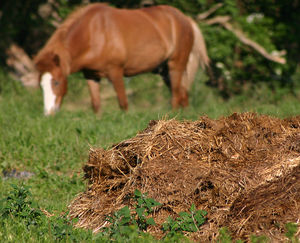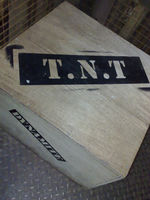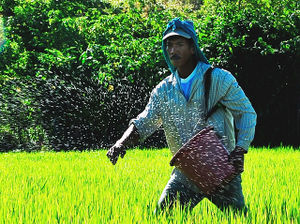Fertilizer
Fertilizer is a chemical or natural substance added to soil or land to increase its fertility. Most chemical fertilizers contain 3 main elements needed by plants - Nitrogen, Phosphorous, and Potassium. The quantity of these contained is the fertilizer is referred to as the NPK count or ratio (NPK being the chemical symbols of those elements). the NPK ratio is very important, because it determines what fertilizer should be used for the specific gardening scenario. There are many methods of applying fertilizer, but they all serve the purpose of nurturing a plant.
History
Based on conventional dating, fertilizer was first used approximately 8,000 years ago, as farmers used manure from their cows to fertilize crops. Around 8,000 B.C., farmers started to cultivate plants and herd animals for the process, but there was no evidence that they would use fertilizer as an aid. However, research concluded that back in that age, manure was used to fertilize. It is thought that farmers saw patches where animals would gather, and their dung would fertilize the grass into a very healthy state. This technique was used around the European continent. [1]
Nitrogen was in high demand in the second World War, considering it was a key component in TNT and other high explosives. The government created ten plants simply to create nitrogen for these weapons. After the war ended, these plants created ammonia for fertilizer. At this point in history, farmers understood how important fertilizer was and the fact that there was a large supply of it caused them to start using it excessively more than before. [2]
Synthesis
To determine where fertilizer comes from, one must know how Ammonia is made. Ammonia is a compound containing nitrogen and hydrogen that is necessary before fertilizer is created. They react with each other at high temperatures and high pressures in reactors and form ammonia. Ammonia is then used as the base for fertilizers, and nitrogen or hydrogen or other materials are added as they are needed. Different soils need different amounts of elements in fertilizers for them to be healthy.
Nitrogen can be absorbed by plant roots in very small amounts once fertilizer is applied. The rest of the nitrogen is either carried away in runoff water or groundwater, or converted into nitrite ions by soil bacteria. Over time, fertilizer degrade the soil, leading to a dependency. Nitrogen is also quite bad for the body, and if nitrite ions are ingested, they get into the blood system and slow down the body from receiving oxygen. [3]
NPK
NPK stands for the ratio of Nitrogen, Phosphorous and Potassium in a fertilizer, and it accounts to the nutrients found in that fertilizer. It will appear as three numbers on the front of any fertilizer container. These three elements are very important for plant health. First off, nitrogen is beneficial for the foliage of a plant, but If a plant has a lot of nitrogen, it will grow quickly but have weak roots. Phosphorous helps in the development and growth of roots and flowers. Finally, Potassium simply betters the plant and makes it healthier. These three elements aren't the only things plants need, but they are certainly important. There are many different types of fertilizers for different types of plants, and the NPK count differentiates which types of fertilizers should be used on certain types of plants. [4]
Plants receive the first three nutrients that they need, Carbon, Hydrogen, and Oxygen, from the sun. The rest are up to fertilizers, which is when the NPK comes into play. Calcium is an important element in plants in their cell membranes and it also neutralizes toxic materials in plants. Magnesium in a element that is the only metallic component found in chlorophyll. It allows plants to process sunlight. Sulfur, an element also needed by plants, is a component of many proteins. [5]
Methods of Application
There are many methods of application when it comes to fertilizer. Broadcasting is a term which means "to evenly distribute fertilizer among an entire field." Fertilizer can be broadcasted while plants are being planted, so the fertilizer will get to them before they have emerged. Fertilizer can also be applied to the standing crops, after they have emerged from the soil. Fertilizers can also be specifically placed in a seeded area for that area to receive special treatment. One method is that fertilizer is placed on the ground, and water floods over it to take it deep into the soil to nurture a certain plant. There are even more methods of fertilization, but they all serve the purpose of nurturing and healthily growing a plant. [6]
Video
This video shows a man shooting at a fertilizer bomb. Once the bomb is hit, it explodes, showing the power in a fertilizer bomb. v=
References
- ↑ Fertilizer has a long history News Observer 28 July, 2013 (Date-of-publication).
- ↑ Postwar Fertilizer Explodes Farming in the 1940's 31 March 2014 (Date-of-Access).
- ↑ Synthetic Nitrogen Fertilizers Organic Valley 15 April 2014 (Date-of-Access).
- ↑ Explanation of NPK and Fertilizers Clean Air Gardening. 1 April 2014 (Date-of-Access).
- ↑ Fertilizer Basics Gardeners. 1 April 2014 (Date-of-Access).
- ↑ Methods of Fertilizer Application My Agriculture Information Bank. 14 April, 2014 (Date-of-Access).
| ||||||||||||||



